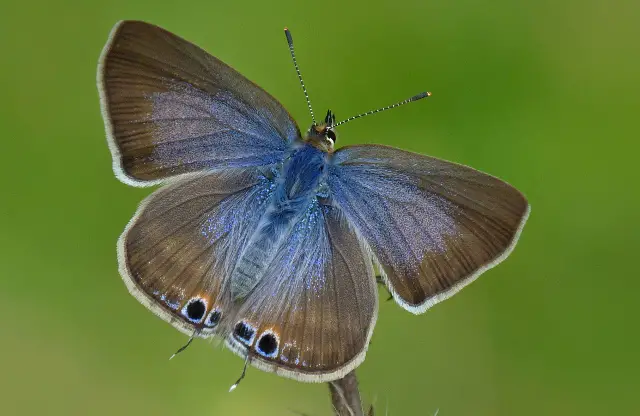Thanks to Katie from Butterfly Conservation for this latest news. Ed
A striking continental butterfly has emerged on the South Coast in record numbers for the second time in three years, Butterfly Conservation (BC) has revealed.
More than 60 Long-tailed Blue butterflies have been seen from Suffolk to Dorset since August in what is thought to be the second largest emergence of the butterfly in UK history.
Experts believe climate change is behind this butterfly reaching our shores more regularly and in vastly increased numbers.
Long-tailed Blue
The Long-tailed Blue is an exotic migrant from the Mediterranean with a handful typically reaching UK shores each year, but experts believe climate change is behind this butterfly reaching our shores more regularly and in vastly increased numbers.
Migrating butterflies crossed the Channel in August and laid 1000s of eggs in gardens and allotments along the South Coast.
BC’s Neil Hulme said:
“I can’t stress how exciting this is – we have seen one of the largest ever migrations of this butterfly into the UK, only exceeded by the record numbers of 2013. Coming so soon after the last major invasion, despite a collapse in the August weather, this really is amazing and I strongly believe climate change has a part to play in this.”
None reported on the Isle of Wight yet
The majority of sightings were in Sussex, where nearly 40 have been spotted, but the butterfly has also been seen in Devon, Dorset, Hampshire, Kent and Suffolk.
UK-born Long-tailed Blue butterflies started to emerge in late September, taking advantage of the unseasonable warm end to September. They were seen on Halloween and now enthusiasts are speculating that the emergence may continue beyond Guy Fawkes Night.
The Long-tailed Blue butterfly has previously been considered a very rare visitor to the UK, despite being abundant across southern Europe, Africa, Asia and Australia.
First spotted in 1859
It was seen for the very first time in Britain in 1859, but over the next 80 years only 30 adults were recorded here. Although significant influxes occurred in 1945 and 1990, these events were relatively small when compared to the invasion of 2013, when 109 sightings were recorded between July and October.
Neil said:
“This is one of the world’s more successful species of butterfly. It may be small, but it’s a very powerful flyer capable of crossing mountain ranges and seas.
“In hot weather it can go through its entire life cycle in just over a month, which is half the period taken by many species. The caterpillar grows up inside the flowers and pods of peas and similar plants, hidden away from predators. It has the full toolkit for world domination.
“The one thing which holds it back is that it can’t survive the winter this far north, but to see this number of Long-tailed Blues entering the UK again does suggest that the species is undergoing a significant change in its geographical spread. I suspect that its zone of permanent residency in southern Europe is extending northwards in response to climate change, bringing it within closer range to the South of England.”
Wispy tails
The butterfly gets its name from the wispy ‘tails’ on the trailing edge of each of its hindwings, which flutter in the breeze. Adjacent eye spots fool birds into thinking this is the head of the butterfly, allowing it to escape any attacks unharmed.
The male is a striking violet-blue colour, while the female is a mix of duller blue and brown. The underside of both sexes is a sandy brown colour crossed by numerous white, wavy lines.
Please report any Long-tailed Blue sightings to: [email protected]
Image: © Neil Hulme, Butterfly Conservation





